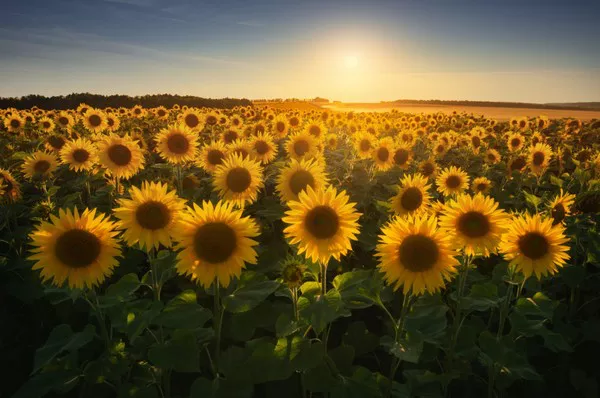Sunflowers, with their bright yellow petals and imposing stature, are among the most iconic and beloved flowers in the world. Their blooms symbolize vitality, warmth, and optimism, making them a favorite choice for gardens, landscapes, and floral arrangements. One of the intriguing aspects of sunflowers is the duration of their bloom, which varies depending on several factors. In this comprehensive guide, we delve into the fascinating world of sunflower blooming, exploring the factors that influence its duration and the stages of this captivating process.
Understanding Sunflower Bloom: A Botanical Overview
The sunflower (Helianthus annuus) is a member of the Asteraceae family and is renowned for its large, daisy-like flowers composed of vibrant yellow ray florets surrounding a central disk. Each sunflower head can contain hundreds or even thousands of individual flowers, creating a stunning display of color and texture. Sunflowers are known for their heliotropic behavior, meaning they track the sun’s movement across the sky throughout the day, a trait observed in young sunflower buds before they fully open.
Factors Influencing Sunflower Bloom Duration
The duration of sunflower blooming can vary depending on several factors, including environmental conditions, sunflower variety, and the specific stage of growth. One of the primary factors influencing bloom duration is temperature, with warmer temperatures typically accelerating the blooming process. Adequate sunlight is also crucial for sunflower bloom, as insufficient light can delay or inhibit flowering. Additionally, factors such as soil fertility, water availability, and pest and disease management can impact the health and vigor of sunflowers, consequently influencing the duration of bloom.
Early Stages of Sunflower Bloom: Bud Formation and Development
The journey of sunflower bloom begins with the emergence of buds, small green structures that gradually grow and develop into mature flowers. Sunflower buds typically form at the terminal ends of sturdy stems, gradually elongating and expanding as they mature. During this stage, the buds exhibit heliotropic behavior, orienting themselves to face the sun and maximize light absorption. As the buds develop, the protective sepals surrounding them begin to separate, revealing the colorful petals nestled within.
See Also: How to plant flowers in a planter?
Peak Bloom: The Height of Sunflower Splendor
The peak of sunflower bloom is a spectacle to behold, with mature flowers unfurling their vibrant petals in a dazzling display of color. At this stage, sunflowers are at their most majestic, with fully opened blooms attracting pollinators and admirers alike. The central disk of the sunflower, composed of tiny individual florets, becomes a hub of activity as bees, butterflies, and other pollinators visit to collect nectar and pollen. Sunflowers at peak bloom are a symbol of abundance, vitality, and the beauty of nature in full bloom.
Post-Bloom: Transitioning to Seed Production
After reaching peak bloom, sunflowers enter the post-bloom stage, during which the flowers begin to fade and senesce. As the petals wilt and fall away, the central disk gradually transforms into a dense cluster of developing seeds. Each floret in the disk represents a potential seed, and as pollination occurs and fertilization takes place, the seeds begin to swell and mature. Sunflowers undergo a remarkable transformation from vibrant blooms to seed-bearing heads, a testament to their reproductive prowess and ecological significance.
Duration of Sunflower Bloom: A Timeline
The duration of sunflower bloom can vary depending on the specific variety, environmental conditions, and management practices. In general, sunflowers typically bloom for a period of two to three weeks, with individual flowers remaining in bloom for several days before senescing and being replaced by new blooms. However, this timeframe can vary significantly depending on factors such as temperature, sunlight, soil moisture, and the health of the plants. Proper care and maintenance, including regular watering, fertilization, and pest control, can help prolong the duration of sunflower bloom and enhance the overall health and vigor of the plants.
Prolonging Sunflower Bloom: Tips for Success
While the duration of sunflower bloom is influenced by various factors beyond our control, there are several steps that can be taken to prolong the blooming period and maximize the beauty of sunflowers in the garden. Planting a diverse range of sunflower varieties with staggered bloom times can ensure a continuous display of flowers throughout the growing season. Providing adequate water and nutrients, maintaining optimal soil fertility, and managing pests and diseases promptly can also support healthy growth and prolonged blooming. Additionally, deadheading spent blooms and removing faded flowers can encourage the production of new blooms and extend the duration of bloom.
Conclusion
In conclusion, the duration of sunflower bloom is a dynamic and captivating process influenced by a multitude of factors, including environmental conditions, variety selection, and plant health. From the emergence of buds to the peak of bloom and the transition to seed production, each stage of the sunflower’s life cycle offers unique beauty and significance. By understanding the factors that influence bloom duration and implementing appropriate care and management practices, gardeners can maximize the beauty and longevity of sunflower bloom, creating a vibrant and inspiring display that celebrates the splendor of nature’s bounty.


